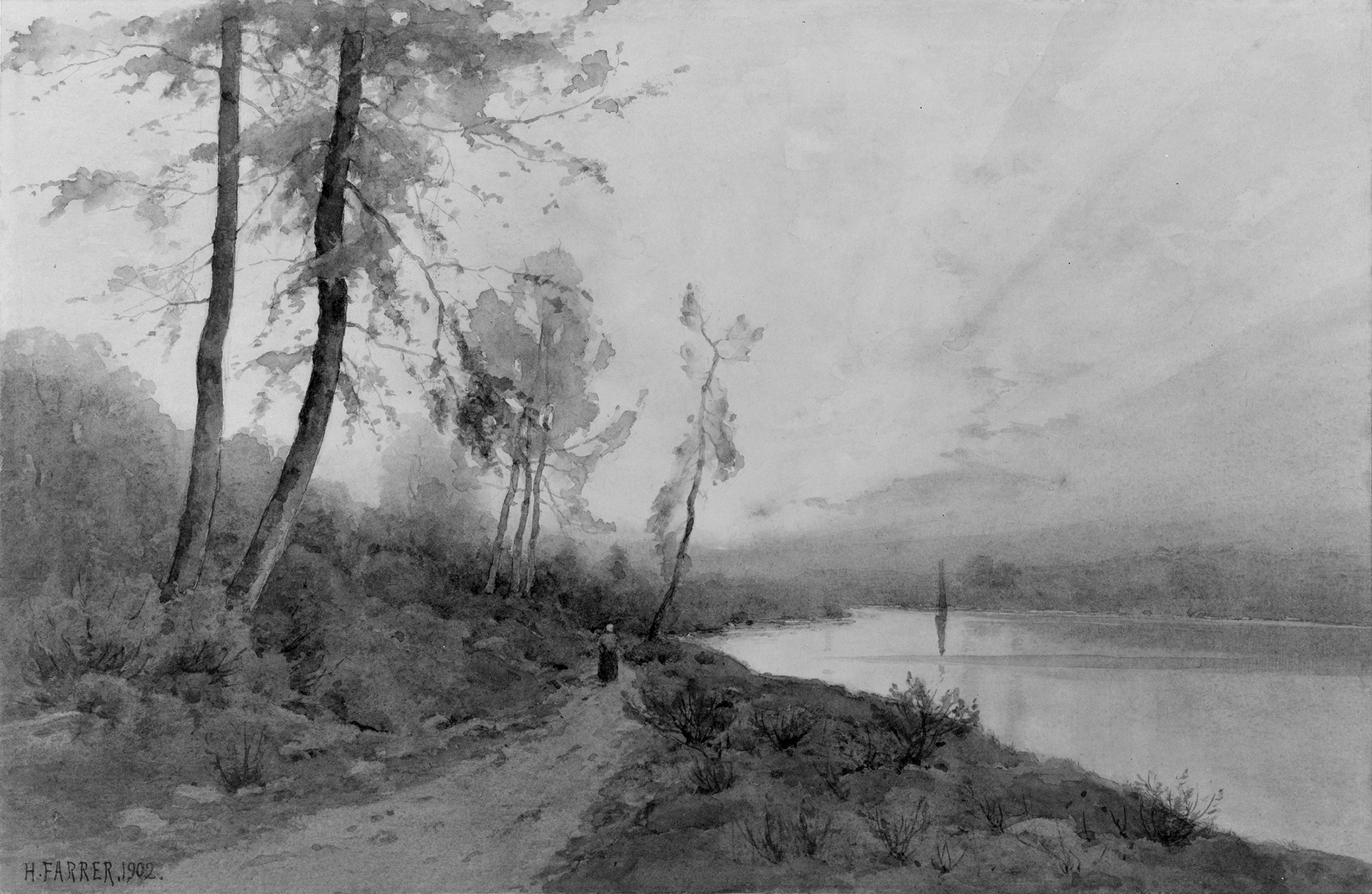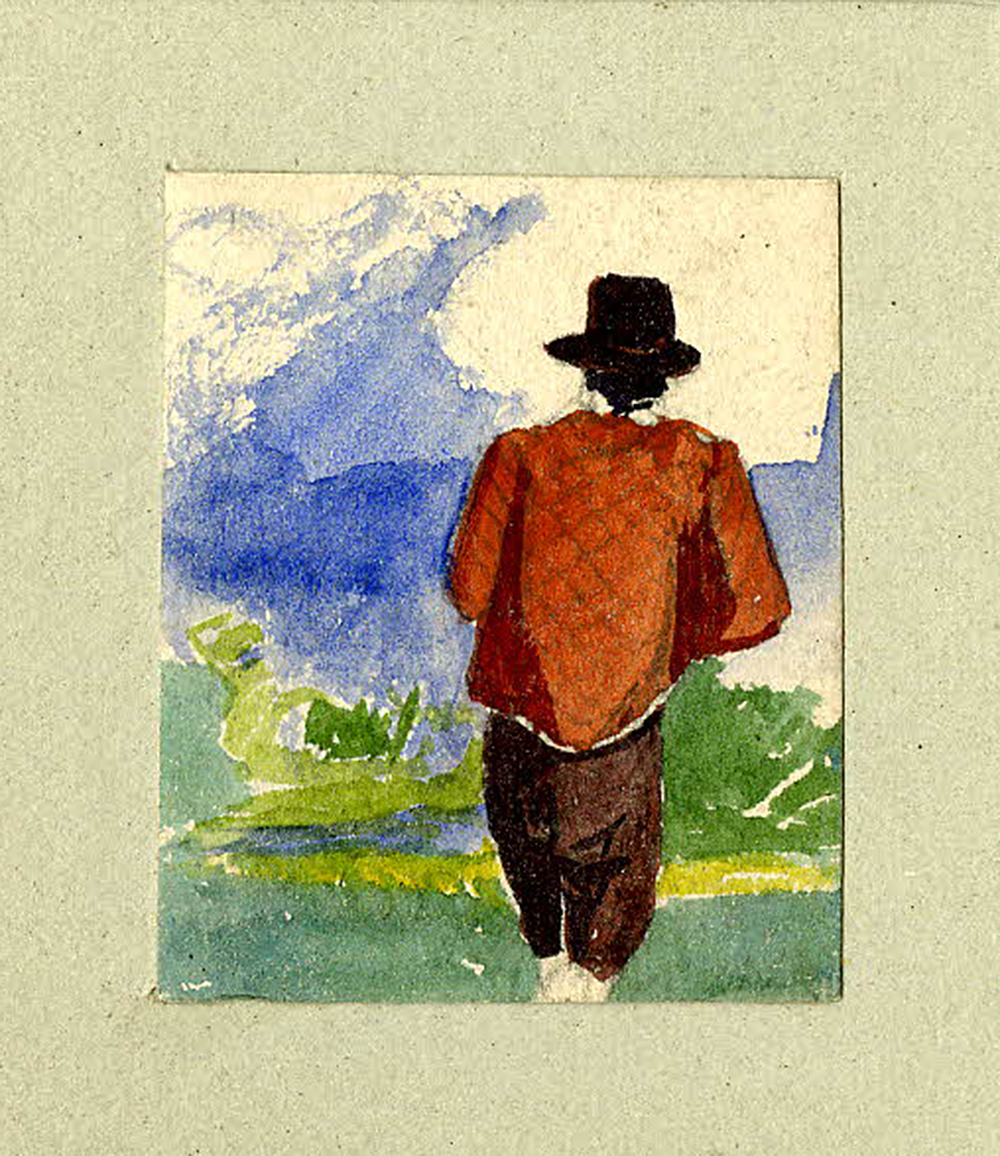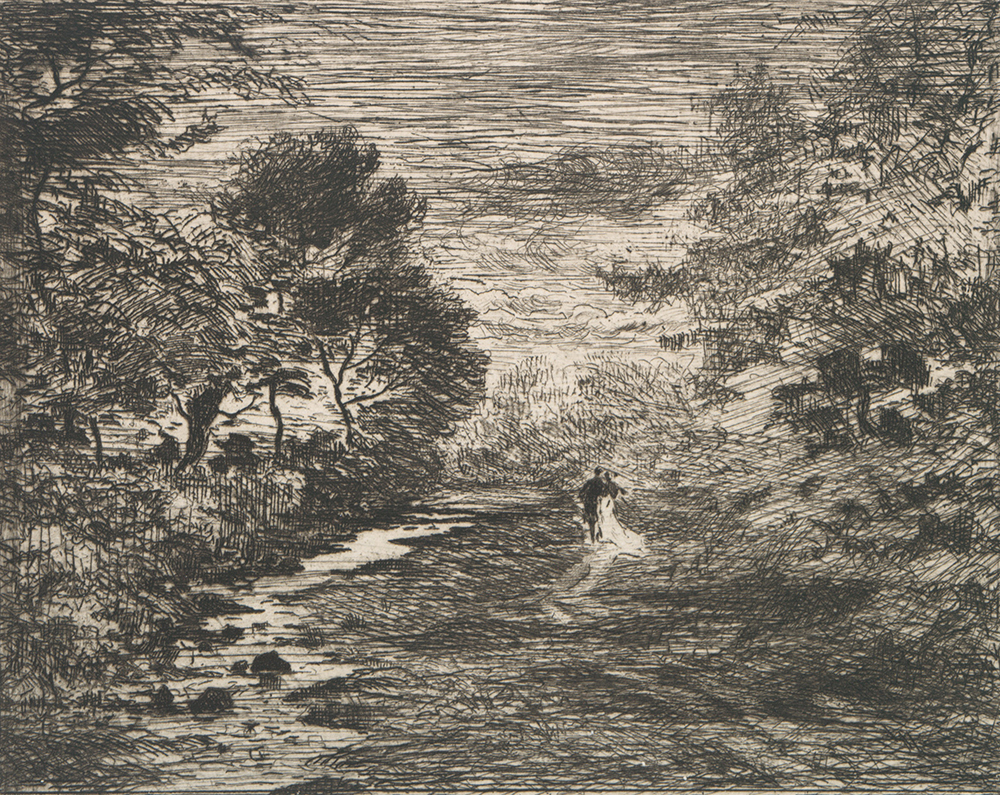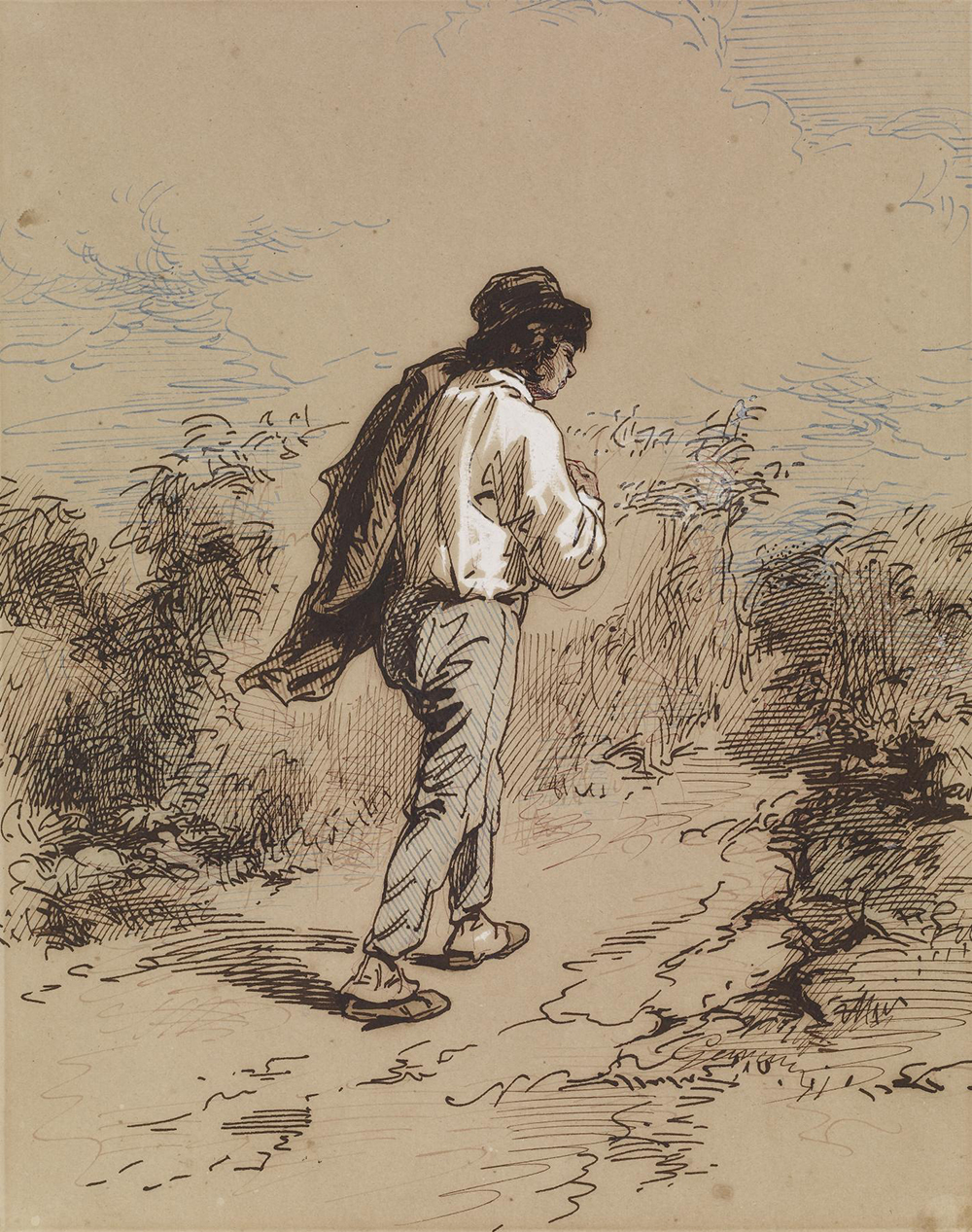
Woman Walking beside a River, by Henry Farrer, 1902. The Metropolitan Museum of Art, Purchase, Bequest of Vera Ruth Miller, by exchange, 1983.
On February 9, 1915, a rising star of British music walked into the recruitment office of the 2nd/5th Gloucestershires and asked to enlist. It was his second attempt to volunteer for the war. Slightly built and bespectacled, the survivor of a breakdown just three years earlier, the twenty-five-year-old Ivor Gurney must have seemed unlikely military material to the officers he faced. They took him anyway. He himself simply believed that the army would help him escape from mental distress—from the pressure of being himself.
This kind of remission always comes to mind when I think about Ivor Gurney, a poet and composer who was born a tailor’s son in the provincial city of Gloucester in 1890. Talent and musical education allowed him to leave behind the limited life a boy from his lower-middle-class background could expect at the beginning of the twentieth century. Yet that first escape, however defining, was never enough. Gurney’s music and poetry, which later entered the canon in Britain and beyond, is famous for the way it returns repeatedly to images of elsewhere, a daydreamed, never-quite-inhabited landscape, as here in “Toasts and Memories”:
Roads against windy skies
At sunset, Severn river,
Red inn-blinds, country cries
That stung the heart with sorrow
And barbed sweet delight…
His life was full of escape attempts, too. He became a great walker away, covering enormous cross-country distances on foot. Eventually, fifteen years before his early death at just forty-seven, he left daily life altogether, entering the quasi-monastic seclusion of an asylum.
Fascinatingly complex and evasive, Gurney has become a key figure in the reassessment of the Edwardian era as something more nuanced than fodder for popular costume drama. Unlike other World War I poets—Wilfred Owen, Siegfried Sassoon, Edward Thomas—Gurney was not officer class. (Only Isaac Rosenberg and David Jones, both visual artists as well as poets, spring to mind as coming from similar backgrounds.) His family home was no Charleston Manor, nor yet an Old Vicarage Grantchester. His equivalents in the literature of his time are pitiful figures: Virginia Woolf’s Septimus Smith, the shell-shocked would-be artist in Mrs. Dalloway, or Leonard Bast, the clerk ruined by dreams of entering an art world that is closed to him in E.M. Forster’s Howards End.
Yet Gurney was neither Smith nor Bast. His extraordinary gifts convinced the artistic establishment figures of his day, musicians such as the great church composer Charles Villiers Stanford and poets including Walter de la Mare, to see past class prejudice and admire his work. They were right to do so. It’s not only the establishment culture of a century ago that Ivor Gurney forces us to reassess, but also the links between music and poetry. An artistic anomaly, he worked at the highest level in both forms: we must go back to the Renaissance poet, composer, and medic Thomas Campion and his contribution to 1601’s Book of Ayres to find anything similar.
Prodigies emerge through talent but also circumstance. Good luck allowed Gurney to receive the best musical training in Britain of the time. After a scholarship to Gloucester Cathedral Choir School, he was apprenticed to the Cathedral organist, alongside Herbert Howells and Ivor Novello (then known as Davies). The Three Choirs Festival, based at the cathedrals of Gloucester, Hereford, and Worcester, was a forcing ground for revolutionary new music. The schoolboy composer—Gurney started writing his own music at fourteen—found himself at the heart of the English music revival, arguably the most enduring manifestation of artistic modernism in Britain. Edward Elgar, Frederick Delius, and Gustav Holst regularly premiered works at the festival. So did Ralph Vaughan Williams, with whom Gurney would eventually study and whose interest in searching out and giving new contexts to traditional music, especially song, would influence the adult Gurney’s work.

Today Vaughan Williams’ The Lark Ascending and Elgar’s Enigma Variations have become cozy listening, British “national treasures,” and it’s difficult to remember how radical these musical landscapes were when fresh. Everything was changing, and fast; yet Gurney’s accomplishment lies partly in the way his music conveys no sense of strain. Everything is continuously integrated, each gesture assured, confident, even tender. His songs and chamber music radiate structure and certainty: what, in his poem “Schubert,” he called the “ordinary good-health technique / of Beethoven.” By contrast his poetry was completely self-taught and audibly experiments with the new modernist musical techniques. The nearest analogy to its startling leaps of thought are the dramatically unexpected harmonic progressions of chromaticists like Claude Debussy or modernists like Béla Bartók. Gurney borrows traditional ballad form and old-fashioned locution, only to juxtapose them with suddenly conversational style.
Much of this vivid, original work emerged in a few short years. In 1911–14, when he first held a scholarship at the Royal College of Music, Gurney was already drawing notice as an exceptional young composer. It seems to have been then, in setting Shakespeare, Fletcher, et al. for Five Elizabethan Songs, that he became interested in writing poetry himself. It was also then that he experienced his first breakdown. He returned to Gloucestershire to recover. Then came World War I. There followed his period of greatest productivity, with performances and publications, friendships and meetings with such important figures as the poet laureate John Masefield.
Despite these artistic achievements, Ivor Gurney failed to fit in with his family, finish his studies, hold down a job, or settle at any address. Unmarried and childless, he struggled repeatedly with his mental health. The war was a defining trauma in his life. Both his acclaimed collections of poetry, Severn and Somme and War’s Embers, were written from the trenches. He was shot in the arm at Ypres and gassed in Passchendaele, and as a result his recurring mental distress was diagnosed as shell shock.
But Gurney’s inner life was also shaped by a powerful countervailing impulse to psychogeography, or “my feet’s place.” His only time abroad was during the war. The iconography of all his work, even that written from his century’s most notorious battlefields, comes from his native countryside. His symbol for this was the River Severn, which flows through his home city of Gloucester and shapes the surrounding countryside that is still, today, a liminal dream landscape, subject to frequent flooding and punctuated by old-fashioned family farms. This is where I grew up, and I know that to walk here is to meet yourself coming back from history. As his most famous song, the heart-stopping “Only the Wanderer,” has it:
And who loves joy as he
That dwells in shadows?
Do not forget me quite,
O Severn meadows.
It’s a kind of lucid dreaming. A poem about a local landmark, “Leckhampton Chimney Has Fallen Down,” incants local hill names as if artful recollection could hold the beloved landscape together.
Gurney boasted that he had been “a night-walker from age sixteen.” At that stage he was already taking twenty-mile nocturnal hikes alone through rural Gloucestershire. Like cycling and boating, walking was a common enough recreation in his day. But what distinguished his walking was its intensity: “Roads are sometimes the true symbolical / Representations of movement in the fate of man,” he wrote in “Roads—Those Roads.” I suspect that to understand the hold walking had on him would be to understand much about what it was like to be Ivor Gurney. Were these long-distance, obsessional tramps a kind of rite, carried out among the “incense bearer” hedges? Were they observational field trips or something much more emotionally extravagant, even sensuous? An untitled poem from 1917 notes, “The fields are full of summer still / And breathe again upon the air… / More sweetness than the sense can bear.” It sounds like an intensely embodied experience, even sublimation, for the lifelong bachelor. Did his boasts about the distances he covered suggest something of an anorexic’s prideful self-mortification? Or were the walks a way to self-soothe, to outpace night terrors? After all, in “The Companions”:
On upland bleak and bare to wind
Beneath a maze of stars I strode;
Phantoms of fear haunted the road,
Dogging my footsteps close behind.
Most interesting for us is what all this walking might have sounded like in the composer-poet’s head. Gurney’s most successful compositions display real confidence in “taking a line for a walk,” to borrow Paul Klee’s definition of drawing. His melodic line is exploratory and wide-ranging, even when he’s setting a ballad like W.B. Yeats’ “Down by the Salley Gardens.” There’s a kind of opening up, a sense of creative release. It’s as if range is musicality. Gurney’s songs often have a running piano accompaniment, the kind of lyrical perpetual motion that first appears in Western art song in Franz Schubert’s “Gretchen at the Spinning Wheel” and “The Trout,” where it’s mimetic. If it mimics anything in Gurney’s work, it is the continual movement of life. You can hear this in probably my favorite piece, his beautifully inevitable sounding setting of Joseph Campbell’s “I Will Go with My Father A-Ploughing.”

Gurney’s poetry sounds like walking in its own way. With its abrupt changes of direction, motet-like “crisscross” rhythms, and grammatical deferments of meaning, it’s peculiarly rhythmic, even dance-like. He often uses the waltzing “triplet” meters we call trochee and anapest and moves from one to the other as if spontaneously. His lines bounce.
Or is it something more obsessional, the rocking or rubbing perpetual motion of psychic distress? Gurney the man was much less integrated than Gurney the artist. Invalided out to a Scottish military hospital in 1917, he fell for his nurse, Annie Drummond. But he was shifted repeatedly between postings and hospitals in northern England and, not surprisingly, Drummond broke it off, precipitating Gurney’s second breakdown. It was the first, however, to be diagnosed as shell shock, though we might be tempted to diagnose a broken heart or existential homelessness.
We glimpse the longing for “the home life which is so strong and sweet a stimulant to any sound art” again in Gurney’s deep friendship with Marion Scott, the musicologist who became his protector and advocate. Friendship seems to have become his emotional mode. His poems celebrate closeness among soldiers, and he had important friendships with his school friend F.W. Harvey, who also became a poet; fellow composer Herbert Howells, another friend from his teens; and his godfather, the Reverend Alfred Cheesman, whose choir and Sunday School he had attended. Cheesman encouraged Gurney to apply for the scholarship to choir school that transformed his life; later, he supplemented his godson’s student scholarship.

But even at the height of his artistic success, in 1919–20, Gurney was manifesting a restlessness that could be seen as the manic phase of a bipolar disorder: taking lengthy night walks—the hundred miles home to Gloucester from London, for example—and sleeping rough, while also searching for a home in the countryside. In 1921 he once again abandoned his studies. The following spring, publishers turned down his third collection. Suddenly he was cut off from the support of the two communities that understood him. His work in both poetry and music was in fact developing and expanding, becoming more elastic and confidently original; but the man himself was having trouble even eating. In September 1922 he moved back home to Gloucester and his brother Raymond, who proved unsympathetic. After repeated suicide threats, Gurney was committed to a local psychiatric hospital.
In December 1922, because he kept absconding on night walks, Gurney was moved from the private Gloucestershire asylum to the huge City of London Mental Hospital near Dartford in Kent. He was never released. Fifteen years later, in 1937, he died there of tuberculosis. It’s here that I can again imagine Ivor Gurney vividly. The sprawling Victorian hospital, renamed Stone House, survived till nearly the end of the twentieth century as a traditional institution of locked wards and endless afternoons. When I was a student, I worked there in the Occupational Therapy Department.
Until 1926 the hospital notebooks are full of poems; there was a burst of fifty songs in 1925 alone. Thereafter the work tails off. Ten years after his incarceration Gurney still pored over maps of Gloucestershire, vividly reimagining the walks he used to take. But far from home, institutionalized and with no possibility of escape from himself, all Gurney’s gifts returned to silence. We owe it to him to listen for their last echoes.